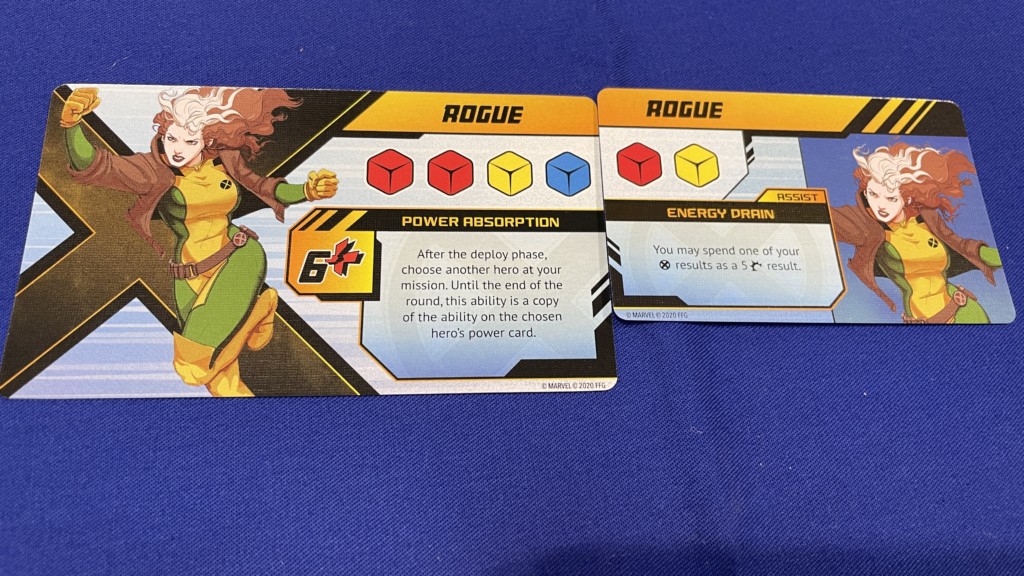X-Men: Mutant Insurrection was near the top of my list going into UKGE 2021.
So it was the first game I played at the event, was I right to prioritise it?
Travel the globe on death-defying missions to recruit new mutants, capture criminals, protect innocent lives, and battle some of the most memorable X-Men supervillains.
X-Men: Mutant Insurrection Game Play
There are 8 plots in the game. All you have to do is pick one and play the game well to complete it to win!
After picking a plot, everyone picks a Hero and gets a Hero card and an Assist card that sits next to it. You also get a standee that goes on a standee of the Blackbird.
You have 3 school cards that are available in every game. These allow you to heal various amounts of damage and have a nice little effect too. Next to these are the Mutant and Bond decks that I’ll talk about later.
There are between 3 and 5 continent decks in the game depending on the player count. These are important as these are where your average everyday missions will appear. One or two of these will be flipped over depending on the player count giving you a number of crises to resolve from the off.
There are other bits and bobs I’ll cover if needed and the plots themselves may have specific setup instructions.

Gameplay is simple and familiar if you have played Elder Sign as this is a bit of a retheme of that game. A round is played over 4 phases:
Deploy Phase
In the deploy phase, players put their standee on a mission card to announce their intention to bring the fight there. Alternatively, they can go to the school to heal up, without having to prevent a crisis or fight a villain.

Mission Phase
Once everyone has deployed, you go to the mission phase. To complete a mission the player rolls dice equal to the colours shown on their character card. A character can get assistance from another hero by placing their assist card on top of theirs, changing the dice they roll to hopefully something more favourable.

You roll the dice with a couple of rerolls trying to fill lines on the mission cards. Some of the symbols will need you to take damage to fill in that space which is always fun. One of the symbols on the dice, Magnetos helmet is villainy which is a real pain. Here, you have to resolve the missions villainy effect to reroll which could include taking damage.
If one of the lines on the card is completed it gets a little cardboard bit to cover it to show it was completed. If all of the lines on a mission are complete it is discarded and you gain the printed bonus.
Story missions from the plot, when completed, allow you to progress in the story. Eventually, the plot will progress into the showdown where you ignore the normal mission cards and go into a larger, multi-card mission.
Once everyone has done this, you move onto the threat phase where it all kicks off.
Threat Phase
Firstly, you raise the threat for each visible exclamation mark on mission, Sentinel and plot cards. This is why you need to clear those missions away, apart from the bonus of course. As the threat rises the game gets harder, if it gets to 15 you lose the game so there’s that.
Then you reveal more missions depending on the player count.
Then you draw a threat card depending on the colour the threat track is currently on.
Regroup Phase
After this is the regroup phase which is a bit of an end of the round tidy up phase. Heroes return to the Blackbird, assist cards are returned to the relevant hero ready for the next round.
If a Hero is locked out, at this stage the player will choose a new hero from those not in the game and they return to play.
I mentioned if you get to 15 threat you lose but you also lose if you can’t draw a red threat or all in player Heroes have been knocked out.
If you progress the plot to the end and complete the showdown, you win!
A couple of other things worth noting. Your hero has a thematic ability but also occasionally you draw mutant cards which are other mutants from the x-men universe that have abilities to help you.

There are also bond cards that bond two players in a mostly but not always negative way. In my game, the other player and I didn’t trust each other meaning we couldn’t use our assist card. That was not fun in a 2 player game!
Finally, Sentinel cards attach to missions and you need to defeat them with dice placement before defeating the mission they attach to. They’re annoying.
Theme
There are a lot of thematic elements.
The plots themselves are thematic as are the mutant abilities, the required teamwork, the positive and negatives bonds and other things. The mutant helpers you get are also thematic with their in-game ability reflecting their mutant ability well.
Missions you don’t deal with will raise the threat track which makes sense.
Setup
A few things change for the player count but apart from that it’s just shuffling stuff most;y.
Components & Artwork
Standees are rarely good but in this, they’re just place holders and they make for a cheaper game! If I owned this and I really wanted to I could use the minis from Marvel United once the X-Men campaign delivers.

Ease of Teaching & Accessibility
It’s an open information co-op so teaching will be easy and it will also help the accessibility of the game.
X-Men: Mutant Insurrection Summary
I mentioned using Marvel United minis in place of the standees and that’s one of the issues this game has for me. Marvel United is more fun, as is the great card game Marvel Champions. Both are co-op superhero games that I enjoy more.
Even if you take out the superhero element, FUSE and Flatline are more fun co-op dice placement games.
So while I do enjoy the gameplay and thematic elements of the game… It just wouldn’t get played if I ever owned it over similar themes, mechanisms or weight games.
Jesta ThaRogue



Leave a Reply